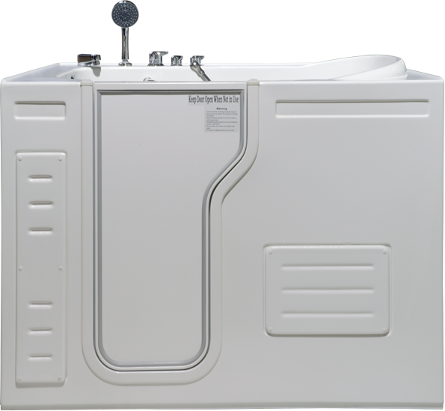Walk-in tubs buyer‘s guide
Why are walk-in tubs becoming features in so many homes? One senior is treated by emergency rooms every 11 seconds and dies every 19 minutes due to falls, resulting in almost three million injuries and 27 million deaths per year. One in every four seniors fall in their homes each year. Falls are the text-base text-gray-900ing cause of fatal and non-fatal injuries to seniors and the biggest threat to their independence and safety. Fall prevention programs focus so heavily on the bathroom because this is where hundreds of thousands of falls happen. What can make bathrooms safer for fall risk individuals?
Walk-in tubs are more than just a relaxing and soothing bath experience. Anyone with mobility issues, balance issues, or range of motion limitations can enjoy the healthy and independent living benefits a walk-in tub provides. Caretakers can also utilize the benefits of a walk-in tub in caring for their loved ones. There are several options in selecting a walk-in tub, each having different pros and cons. Let’s explore to find the right fit for you.
What Is A Walk-In Tub?
The length and width specs of a walk-in is comparable to a standard tub. The difference is usually in the design and amenities. Walk-in tubs and walk-in tub/shower combos have ADA-compliant features, such as built-in seating and grab bars, that make utilizing them easier and safer. The door, for example, swings and seals so that entering and exiting doesn’t require such a high step. While you can find high-end models that do about everything but fold your laundry, most all walk-ins will have these standard features:
- Step-Up - traditional tubs have about 15 inches to step up and over to enter the tub. Walk-in tubs have a lower threshold of three to seven inches, and wheelchair accessible walk-ins have an even lower threshold.
- Watertight Door - the low threshold is created by a door opening that can be designed to swing in or out. Closing requires minimal arm strength for a watertight seal.
- Built-In Seating - comfortable and adjustable seating removes the burden of having to lower and lift yourself to and from the floor of the tub. Seating can even be heated for maximum comfort.
- Hand-Held Shower Head - shower heads are adjustable for spray and can be fixed or attached to a removable wand.
- Depth - while traditional tubs are only around a foot deep, the standard walk-in tub is 2.5 feet deep and has jets and other spa-like features to soothe pains and aches.
Walk-In Tub Brands
Major brands, of course, offer the biggest selection, best pricing, and most comprehensive guarantees and warranties. You don’t want to be burdened with poor customer service or having to deal with maintenance and warranty issues from a less than reputable brand. A dealer rep can come to your home and go over walk-in tub options to fit your home, needs, lifestyle, and budget. Here are a few of the most well-established brands with a history of reputable and quality customer service:
- Universal Tub Design
- American Standard
- Jacuzzi
- TheraTub
- Ella’s Bubbles
Benefits Of A Walk-In Tub
Whether your balance is poor, mobility is limited, have limitations due to obesity or age, or are the caregiver of someone with bathing limitations or risks, a walk-in tub can make life easier, safer, and cleaner. Here’s how:
- Lowers the risk of falls and slips with ADA safety features like handrails, lower threshold, wheelchair access, seating, and non-slip flooring.
- Increases independence and lowers the lift burden for caregivers.
- Relaxing and soothing jets and deep warm water to soothe aches, pains, and stress.
- Soothes muscle, joint, and circulation complications from disease processes like arthritis, neuropathy, and diabetes.
- Customizable to any bathroom and budget.
- Gives you the option of either quick and thorough showering from the safety of secure seating or longer relaxing tub-time in a spa-like environment.
Types Of Walk-In Tubs
Use your needs to help you pick the most appropriate walk-in tub. Different walk-in types come with different features, usually at varying price points. Narrow it down by selecting the type of walk-in tub that best suits your needs:
1. Soaker
- Basic model with good depth.
- Safety is the focus with handrails, built-in seating, slip resistant flooring, and other ADA-compliant features.
- Fast drains for quick exit.
2. Whirpool
- Akin to a spa or hot tub.
- An in-line heater keeps the water warmer longer.
- Safety features prevent water from overheating.
- Jets create bubbles of water.
- Great for hydrotherapy to ease aching, sore, painful joints and muscles; circulation issues; and to rehab injuries.
- Minimal maintenance, but you will need to clean jets and pipes as per the manufacturers instructions, and this may be difficult for those with limited mobility.
3. Aerotherapy & Hydrotherapy
- Warm and humid air from bubbling air jets provide aerotherapeutic benefits for those with respiratory and sinus issues.
- Tubs usually have about 10 jets.
- Temperature control.
- Maximum depth for full body immersion and joint, muscle, and circulation benefits.
- These can be customized with low-impact resistance exercise and aqua therapy equipment, such as a treadmill, to help strengthen and/or rehab muscles and joints.
4. Bariatric
- At 30 or more inches wide, bariatric walk-ins have much wider specs than traditional tubs.
- Wider doors and seating than other walk-in tub models.
- Low threshold, grab bars, and textured floors retain ADA-compliant safety features.
- Ideal for individuals 300 to 600 pounds.
5. Wheelchair Accessible
- Larger, outward swinging doors and clear space between the seat and wheelchair access.
- Built-in ramp or very minimal threshold to support wheelchair access.
- ADA-compliant safety features.
- Depth of 65 gallons and size of 60x30.
- Whirlpool and air jets are usually not standard, but they can be added for an extra cost.
What Should I Expect to Pay For A Walk-In Tub?
Overall Cost Estimate
The first point to keep in mind is that that you’ll incur two separate costs. The first cost is the walk-in itself and any additional features you add to the model. Installation is the second cost, which involves actually placing and hooking the walk-in up in your bathroom. Add these two together to estimate the walk-in tub’s total cost
Medicare And Medicaid Help
Medicare will rarely help pay for either cost of a walk-in tub. In rare cases where they do, it’s only the cost of the tub that’s reimbursable. Medicaid is most likely to cover therapeutic walk-ins for doctor orders in cases of chronic muscle and joint pain, but this varies greatly by state program.
Showroom Demos
Local distributors and showrooms offer you a chance to touch and see the walk-in tub models up close and personal. However, do keep in mind that you’ll also incur a markup price of anywhere from 25%-35% since they’ll need to make a middleman profit. Expectant price off a showroom or local distributor floor:
- Tub - $4,000 - $8,000
- Installation - $1,500 -$3,000
Online Retailers
Online retailers typically offer the biggest selection and best price points, but you’ll need to carefully vet the retailer to ensure they’re offering a quality product. Some use imported tubs with low quality components to offer those low prices, and you’ll find customer service is nil after the purchase has been made. It’s always prudent to stick with reputable brands, even if you pay a little more. You’ll also want to check that your area is covered in the manufacturer’s installation service area if you don’t have an independent plumbing specialist lined up for the installation. Expectant cost of a walk-in with an online retailer:
- Tub- $1,500 - $7,500
- Installation - $1,500 - $3,000
In-Home Sales Rep
Sales reps for walk-ins can be independent or a direct representative of a manufacturer. In either case, an in-home consultant comes to your home and assesses your bathroom and needs so that they can offer your customized options. The upside is that you have someone face-to-face to help you navigate the process and tailor a comprehensive solution to meet your needs. The downside is that the sales rep is likely going to push their product for a sale and possibly push more features than you really need for a higher cost. Installation and tub price are usual sold as a combo. A good rule of thumb in pricing is that, extensive remodel of the bathroom aside, a walk-in shouldn’t cost more than $10,000. Expectant cost:
- Tub and installation - $5,000- $20,000
National Retailers
Home Depot, Lowe’s, and other big box retailers have a good selection of walk-in tubs in their online catalog. Depending on location, some may even have floor models for you to examine in-store. They usually offer a good warranty, return policy, and fair pricing. The downside is that customer service reps may not be as knowledgeable about the product as a manufacturer or independent sales rep and not be able to assist you in figuring out features as they relate to your needs. Installation is also rarely connectable. The national retailer’s sales staff may be able to point you in the general direction of a local plumber, but that’s about it. Expectant cost:
- Tub - $2,500 - $6,000
- Third-party Installation - $1,500 - $3,000

